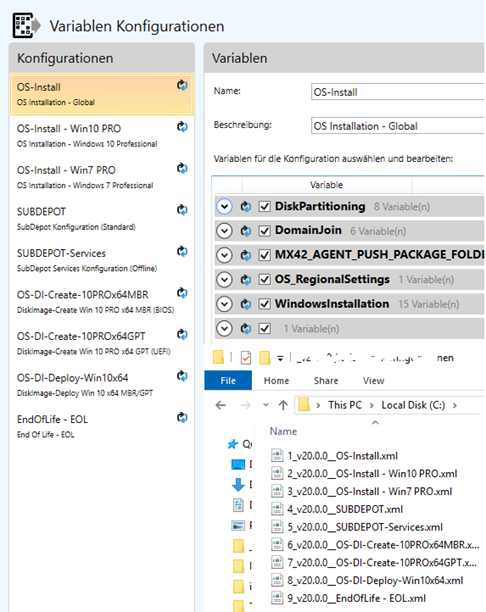Concept and description
The possibility to import variable configurations requires Empirum v21.0.3!
The Matrix42 Variable Configuration OSI template allows to import, edit and assign OS installation specific variable configurations.
The Matrix42 Variable Configuration OSI template contains12 (v21.0.3) and 16 (v22.0) exported files that can be imported with EMC or SDK/UUX upload.
- 1_v...__OS-Install.xml
- 2_v...__OS-Install - Win10 PRO.xml
- 3_v...__OS-Install - Win7 PRO.xml
- 4_v...__SUBDEPOT.xml
- 5_v...__SUBDEPOT-Services.xml
- 6_v...__OS-DI-Create-10PROx64MBR.xml
- 7_v...__OS-DI-Create-10PROx64GPT.xml
- 8_v...__OS-DI-Deploy-Win10x64.xml
- 9_v...__EndOfLife - EOL.xml
- 10_v...__OS-Install - Win11 PRO.xml
- 11_v...__OS-Install - Server 2019.xml
- 12_v...__OS-Install - Server 2022.xml
Each individual file can be imported over the EMC and is deposited as an independent configuration. Each configuration contains different variables with a predefined content.
This content can/must be adapted for each individual Empirum environment!
The deposited configurations serve as a template, so that all OS installation specific variables can be set and assigned over a variable configuration!
Matrix42 Variable Configurations OSI
The first variant of the Matrix42 Variable Configuration OSI template is a ZIP file containing exported OS installation specific variable configurations. The different variants contain all variables required for a normal OS installation with WinPE.

The following variables must be checked and adjusted:
- OS-Install > DomainJoin > DomainJoin.DomainJoinCredentialsUser
- OS-Install > DomainJoin > DomainJoin.DomainJoinCredentialsPassword
- OS-Install > WindowsInstallation > LocalUserName
- OS-Install > WindowsInstallation > LocalUserPassword
- OS-Install > WindowsInstallation > LocalUserDisplayName
- OS-Install - Win7 PRO > DriverIntegration > DriverArchiveFileName
- FQDN
- SUBDEPOT > USER_1
- SUBDEPOT > PASSWORD_1
- SUBDEPOT > ROOTPATH
- SUBDEPOT-Services > PXE_DNS
- SUBDEPOT-Services > PXE_GATEWAY
- SUBDEPOT-Services > PXE_IP
- SUBDEPOT-Services > PXE_SERVERMODE
- SUBDEPOT-Services > PXE_SERVICE
- SUBDEPOT-Services > PXE_SUBNET
- OS-DI-Create-10PROx64MBR > DESTINATION
- OS-DI-Create-10PROx64MBR > PASSWORD
- OS-DI-Create-10PROx64MBR > SHARE
- OS-DI-Create-10PROx64MBR > USERNAME
- OS-DI-Create-10PROx64GPT > DESTINATION
- OS-DI-Create-10PROx64GPT > PASSWORD
- OS-DI-Create-10PROx64GPT > SHARE
- OS-DI-Create-10PROx64GPT > USERNAME
- OS-DI-Deploy-Win10x64 > DiskImageDeploy > LocalUserName
- OS-DI-Deploy-Win10x64 > DiskImageDeploy > LocalUserPassword
- OS-DI-Deploy-Win10x64 > DiskImageDeploy > LocalUserDisplayName
- OS-DI-Deploy-Win10x64 > M42_INTERNAL_OS_IMAGING_SETTINGS > DISKIMAGING_PASSWORD
- OS-DI-Deploy-Win10x64 > M42_INTERNAL_OS_IMAGING_SETTINGS > IMAGEFILE_GPT
- OS-DI-Deploy-Win10x64 > M42_INTERNAL_OS_IMAGING_SETTINGS > IMAGEFILE_MBR
All variables have to be checked by you, if they can be used for your environment. In general a deployment works with these settings!